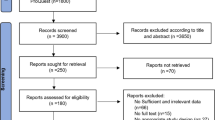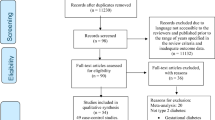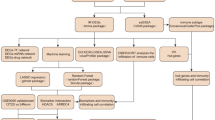Abstract
MicroRNAs (miRNAs) negatively regulate target gene expression by binding to 3′-untranslated region of target mRNA. Single-nucleotide polymorphisms (SNPs) that reside in the miRNA target sites can affect the bindings of miRNAs to mRNAs. Compelling evidence has shown that miRNAs contribute to the etiology of type 2 diabetes (T2DM). We hypothesized that SNPs in diabetes-related miRNA target-binding sites could be associated with the risk of T2DM. We selected 10 SNPs on miRNA-binding sites by using bioinformatics software. Genotypes of T2DM patients (n=1017) and normal controls (n=1059) were analyzed by TaqMan assay. The variant genotypes rs1366600CC and TC/CC in the insulin receptor (INSR) gene, rs2292899GA in the acyl-CoA synthetase 1 (ACSL1) gene and rs11724758AA in the fatty-acid-binding protein 2 (FABP2) gene were associated with T2DM (adjusted odds ratios (ORs) (95% confidence intervals)=2.03 (1.02–4.01), 1.28 (1.04–1.57), 1.22 (1.004–1.49) and 0.76 (0.58–0.997), respectively). The analysis stratified by age, gender, waist circumstance and living habits also revealed these genotypes’ effect. Furthermore, crossover analysis indicated those who exposed to both environmental factor and putative risk genotypes did have the highest risk of T2DM. A cumulative effect of SNPs rs1366600, rs2292899 and rs11724758 was observed with individuals carrying 2, 3 and 4–6 risk alleles having a gradually increased risk of T2DM (OR=1.52, 1.81 and 2.28, P for trend <0.001). Our result suggested that INSR rs1366600, ACSL1 rs2292899 and FABP2 rs11724758 could influence the susceptibility to T2DM in Chinese Han population, most likely through their effects on the specific miRNA-binding sites and functional characterizations of three genes are needed.
Similar content being viewed by others

Log in or create a free account to read this content
Gain free access to this article, as well as selected content from this journal and more on nature.com
or
References
Guay, C., Roggli, E., Nesca, V., Jacovetti, C. & Regazzi, R. Diabetes mellitus, a microRNA-related disease? Transl. Res. 157, 253–264 (2011).
Yang, W., Lu, J., Weng, J., Jia, W., Ji, L., Xiao, J. et al. Prevalence of diabetes among men and women in China. New Engl. J. Med. 362, 1090–1101 (2010).
Lynn, F. C. Meta-regulation: microRNA regulation of glucose and lipid metabolism. Trends Endocrinol. Metab. 20, 452–459 (2009).
Dehwah, M. A., Xu, A. & Huang, Q. MicroRNAs and type 2 diabetes/obesity. J. Genet. Genomics 39, 11–18 (2012).
Chen, K., Song, F., Calin, G. A., Wei, Q., Hao, X. & Zhang, W. Polymorphisms in microRNA targets: a gold mine for molecular epidemiology. Carcinogenesis 29, 1306–1311 (2008).
Abelson, J. F., Kwan, K. Y., O'Roak, B. J., Baek, D. Y., Stillman, A. A., Morgan, T. M. et al. Sequence variants in SLITRK1 are associated with Tourette's syndrome. Science 310, 317–320 (2005).
Mishra, P. J., Humeniuk, R., Mishra, P. J., Longo-Sorbello, G. S., Banerjee, D. & Bertino, J. R. A miR-24 microRNA binding-site polymorphism in dihydrofolate reductase gene leads to methotrexate resistance. Proc. Natl Acad. Sci. USA 104, 13513–13518 (2007).
Chin, L. J., Ratner, E., Leng, S., Zhai, R., Nallur, S., Babar, I. et al. A SNP in a let-7 microRNA complementary site in the KRAS 3’untranslated region increases Non–small cell lung cancer risk. Cancer Res. 68, 8535–8540 (2008).
Poy, M. N., Eliasson, L., Krutzfeldt, J., Kuwajima, S., Ma, X., Macdonald, P. E. et al. A pancreatic islet-specific microRNA regulates insulin secretion. Nature 432, 226–230 (2004).
Kong, L., Zhu, J., Han, W., Jiang, X., Xu, M., Zhao, Y. et al. Significance of serum microRNAs in pre-diabetes and newly diagnosed type 2 diabetes: a clinical study. Acta Diabetol. 48, 61–69 (2010).
Lovis, P., Gattesco, S. & Regazzi, R. Regulation of the expression of components of the exocytotic machinery of insulin-secreting cells by microRNAs. Biol. Chem. 389, 305–312 (2008).
Ramachandran, D., Roy, U., Garg, S., Ghosh, S., Pathak, S. & Kolthur-Seetharam, U. Sirt1 and mir-9 expression is regulated during glucose-stimulated insulin secretion in pancreatic β-islets. FEBS J. 278, 1167–1174 (2011).
Tang, X., Muniappan, L., Tang, G. & Ozcan, S. Identification of glucose-regulated miRNAs from pancreatic {beta} cells reveals a role for miR-30d in insulin transcription. RNA 15, 287–293 (2009).
Lovis, P., Roggli, E., Laybutt, D. R., Gattesco, S., Yang, J. Y., Widmann, C. et al. Alterations in microRNA expression contribute to fatty acid-induced pancreatic beta-cell dysfunction. Diabetes 57, 2728–2736 (2008).
Zampetaki, A., Kiechl, S., Drozdov, I., Willeit, P., Mayr, U., Prokopi, M. et al. Plasma microRNA profiling reveals loss of endothelial miR-126 and other microRNAs in type 2 diabetes. Circ. Res. 107, 810–817 (2010).
Krek, A., Grun, D., Poy, M. N., Wolf, R., Rosenberg, L., Epstein, E. J. et al. Combinatorial microRNA target predictions. Nat. Genet. 37, 495–500 (2005).
Bravo-Egana, V., Rosero, S., Molano, R. D., Pileggi, A., Ricordi, C., Dominguez-Bendala, J. et al. Quantitative differential expression analysis reveals miR-7 as major islet microRNA. Biochem. Biophys. Res. Commun. 366, 922–926 (2008).
He, A., Zhu, L., Gupta, N., Chang, Y. & Fang, F. Overexpression of micro ribonucleic acid 29, highly up-regulated in diabetic rats, leads to insulin resistance in 3T3-L1 adipocytes. Mol. Endocrinol. 21, 2785–2794 (2007).
Esau, C., Kang, X., Peralta, E., Hanson, E., Marcusson, E. G., Ravichandran, L. V. et al. MicroRNA-143 regulates adipocyte differentiation. J. Biol. Chem. 279, 52361–52365 (2004).
Klöting, N., Berthold, S., Kovacs, P., Schon, M. R., Fasshauer, M., Ruschke, K. et al. MicroRNA expression in human omental and subcutaneous adipose tissue. PLoS ONE 4, e4699 (2009).
Hennessy, E., Clynes, M., Jeppesen, P. B. & O’Driscoll, L. Identification of microRNAs with a role in glucose stimulated insulin secretion by expression profiling of MIN6 cells. Biochem. Bioph. Res. Commun. 396, 457–462 (2010).
Baroukh, N., Ravier, M. A., Loder, M. K., Hill, E. V., Bounacer, A., Scharfmann, R. et al. MicroRNA-124a regulates Foxa2 expression and intracellular signaling in pancreatic beta-cell lines. J. Biol. Chem. 282, 19575–19588 (2007).
Hiard, S., Charlier, C., Coppieters, W., Georges, M. & Baurain, D. Patrocles: a database of polymorphic miRNA-mediated gene regulation in vertebrates. Nucleic Acids Res. 38, D640–D651 (2010).
Ziebarth, J. D., Bhattacharya, A., Chen, A. & Cui, Y. PolymiRTS database 2.0: linking polymorphisms in microRNA target sites with human diseases and complex traits. Nucleic Acids Res. 40, D216–D221 (2012).
Lewis, B. P., Burge, C. B. & Bartel, D. P. Conserved Seed pairing, often flanked by adenosines, indicates that thousands of human genes are MicroRNA targets. Cell 120, 15–20 (2005).
Betel, D., Wilson, M., Gabow, A., Marks, D. S. & Sander, C. The microRNA.org resource: targets and expression. Nucleic Acids Res. 36, D149–D153 (2008).
Malodobra, M., Pilecka, A., Gworys, B. & Adamiec, R. Single nucleotide polymorphisms within functional regions of genes implicated in insulin action and association with the insulin resistant phenotype. Mol. Cell Biochem. 349, 187–193 (2011).
Lobo, S., Wiczer, B. M. & Bernlohr, D. A. Functional analysis of long-chain acyl-CoA synthetase 1 in 3T3-L1 adipocytes. J. Biol. Chem. 284, 18347–18356 (2009).
Baier, L. J., Sacchettini, J. C., Knowler, W. C., Eads, J., Paolisso, G., Tataranni, P. A. et al. An amino acid substitution in the human intestinal fatty acid binding protein is associated with increased fatty acid binding, increased fat oxidation, and insulin resistance. J. Clin. Invest. 95, 1281–1287 (1995).
Ning, J., Hong, T., Yang, X., Mei, S., Liu, Z., Liu, H. Y. et al. Insulin and insulin signaling play a critical role in fat induction of insulin resistance in mouse. Am. J. Physiol. Endocrinol. Metab. 301, E391–E401 (2011).
Acknowledgements
We would like to thank Priority Academic Program Development of Jiangsu Higher Education Institutions (PAPD).
Author information
Authors and Affiliations
Corresponding author
Ethics declarations
Competing interests
The authors declare no conflict of interest.
Additional information
Supplementary Information accompanies the paper on Journal of Human Genetics website
Supplementary information
Rights and permissions
About this article
Cite this article
Zhao, X., Ye, Q., Xu, K. et al. Single-nucleotide polymorphisms inside microRNA target sites influence the susceptibility to type 2 diabetes. J Hum Genet 58, 135–141 (2013). https://doi.org/10.1038/jhg.2012.146
Received:
Revised:
Accepted:
Published:
Issue date:
DOI: https://doi.org/10.1038/jhg.2012.146
Keywords
This article is cited by
-
Associations between genetic variations in microRNA and myocardial infarction susceptibility: a meta-analysis and systematic review
Herz (2022)
-
MicroRNAs and Synaptic Plasticity: From Their Molecular Roles to Response to Therapy
Molecular Neurobiology (2022)
-
Polymorphisms in miRNA binding sites involved in metabolic diseases in mice and humans
Scientific Reports (2020)
-
Investigation of miRNA-binding site variants and risk of gestational diabetes mellitus in Chinese pregnant women
Acta Diabetologica (2017)
-
The pre-mir-27a variant rs895819 may contribute to type 2 diabetes mellitus susceptibility in an Iranian cohort
Journal of Endocrinological Investigation (2016)


